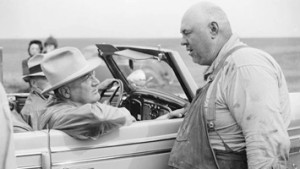
President Franklin D. Roosevelt visited the drought stricken Texas Panhandle in July 1938. Here he listens as an unidentified farmer explains the crisis. Ironically as FDR rode toward an Amarillo park for a speech, the sky opened and the rains came! (Photo courtesy of www.history.com.)
I vividly remember the spring of 1957. We lived in Jacksboro at the time. I was just a little kid, but it was one of those once in a lifetime experiences for me. For four or five years everyone had suffered through a devastating drought with stringent water rationing, little water or grass for cattle, dust storms that left a dirty, dusty taste in the mouth, absolutely nothing pleasant! Suddenly the rains began, slowly at first but more and more each week.
People started carrying umbrellas. I had never seen that before. Streets filled with water; another new experience for me. I remember standing at the window watching the rain in awe. I thought it was absolutely wonderful. Everyone was so happy; smiles beamed on the crustiest old cowboy’s faces. Then I happened to hear the television weatherman say we were approaching forty days of rain. Forty days of rain? That was how long Noah floated on his ark with all those animals. My dad reassured me it would take much more than forty days to flood Jacksboro and the surrounding area.
Fast forward to 1980 when our son was born in April. That night I think Greenville had its last cold front and spring storm for a long time. That was the year the temperature reached 113 degrees on two or three days. A record number of hundred plus degree-days plagued North Texas. Obviously with those high temperatures, we had no rain. In late September or early October a rain cloud came up. I bundled Matthew up and took him out on the front porch. I talked to him about rain and how precious it was. I even took his little hand and let the raindrops fall on it. I doubt if he remembers, but he surely appreciates the need for water conservation as an adult.
As I’ve done several research projects I learned that Texas and the rest of the South suffered a severe drought from 1860 until the summer of 1865. As former Confederate soldiers made their ways home, they encountered rising creeks and rivers. Some foolishly plunged their horses into the roiling water and lost their lives so very close to home. The drought had taken a toll on women alone on the frontier. Many were on the brink of starvation when their husbands or sons returned. But when the rains began, the drought eased into a horrible memory.
One time I read a lot about the Dust Bowl in the Texas Panhandle, caused by a devastating drought and poor farming techniques. I’m sure you have seen the photographs. At some point, President Franklin Roosevelt arrived in Amarillo to see for himself the ravages of weather. As soon as he got in his car for the parade through town, it started to rain. Not a gentle shower, but a real gully-washer. That was the beginning of the end of that drought.
As long as we live in Texas we will have to deal with weather, including droughts. But as I have watched the rain this spring, I am so excited that the end of this drought may be just down the road. The pond in my yard caught some water, the tulips I planted in December are absolutely beautiful, and the cows have an abundance of water and grass. What more could one ask for in Texas?
